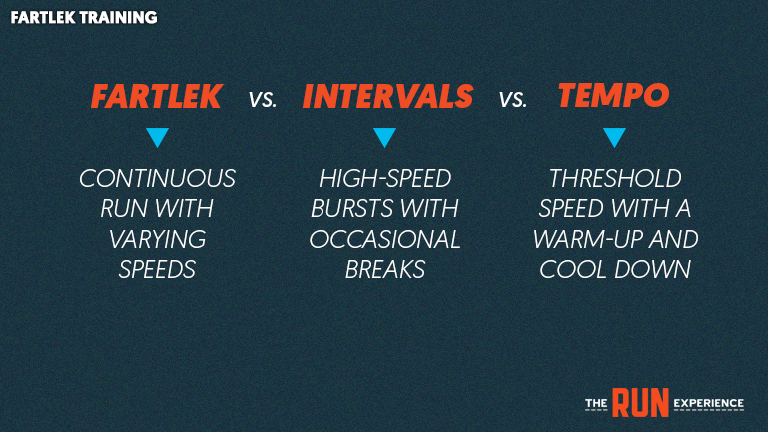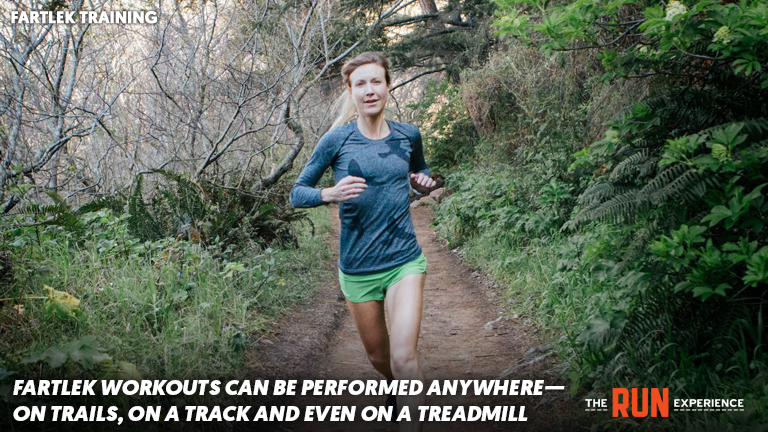Fartlek Training: What Is It, Benefits, Tips, and Workouts
Think you know how to do fartlek training? Discover what is a fartlek workout, its benefits, training tips, and real-life examples.

Fartlek training is more than just a funny word—it’s a game-changing workout that can do wonders for your heart rate.
Runners are constantly searching for new workouts to add to their training plan. Running workouts need to be varied in order to push the body to new feats and allow it time for rest and recovery.
If you run with the same hard effort for every training session, you’ll get burnt out. Variety is the secret ingredient for successful high-intensity interval training workouts, and variety is what fartleks are all about.
Below, we’ll explain everything you need to know about fartlek training:
- What is a fartlek run?
- Fartlek training for beginners
- How to do a fartlek run?
- Fartlek runs vs. tempo runs
- Benefits of a fartlek run
- Fartlek training workouts
Fartlek Training: The Complete Overview
For experienced runners, many turn to a fartlek run as a new challenge that breaks up their normal routine. Fartlek sessions are a challenging workout that pushes runners outside their comfort zone and combines a mix of warm-up pace, speed work, sprinting, and cool-downs into a constant interval training session designed to increase your heart rate.
What Is a Fartlek Training Run?
A fartlek run is defined as “continuous training with interval training.” The word “fartlek” is Swedish for “speed play,” highlighting its focus on a medley of fast and slow bursts of running during the duration of the workout.

Fartlek running is a form of interval training that keeps the runner in constant motion. It is a long run featuring varied lengths of resting pace and fast-pace segments. Fartlek training can be done anywhere and isn’t considered just a track workout.
- Fartlek Definition: A unique blend of continuous running with intervals of varying speed and intensity seamlessly integrated into the workout. A playful and unstructured approach to mixing fast and slow running.
- Fartlek Meaning: The term "Fartlek" is a Swedish word that translates to "speed play." This form of training is a blend of continuous running with variable intensity, mixing faster running with periods of slower running.
- Fartlek Training Is Best Described like the improvisational flow of jazz music, where the rhythm and intensity spontaneously change, creating a harmonious blend of varied paces.
What Is Fartlek Training?
Fartlek training incorporates fartlek runs into your weekly routine. It does not mean that all you do is fartlek runs—you’re just adding these into your schedule.
Since fartlek training involves up-tempo paces, it’s best to cycle these in week to week with your tempo runs and interval training. These can all be challenging workouts, so we recommend just doing one per week and cycling weeks for which one you do.
Of course, if you like fartlek training and feel like it’s giving you great performance gains, cycle it in more often.
Fartlek Runs vs. Tempo Runs vs. Interval Runs: What’s the Difference?
So, are we introducing fartleks into our training plans just because it’s a cool name? Well, if it sounds strikingly close to interval training and tempo runs, you’re not wrong. A fartlek is a type of interval run that incorporates tempo. However, there are still key differences between the three:

Get more daily workouts from our coaches right here
As you can see, a fartlek is a continuous run with varying speeds, while interval training sometimes allows you to take a brief rest. Tempo runs involve a warm-up and cool-down with your threshold speed mixed in the middle.
Fartlek vs. Interval
Both fartlek and interval training methods aim to improve speed and endurance but differ in structure and execution. Fartlek is more spontaneous and flexible, allowing runners to adjust their intensity based on instinct and environmental cues.
It's less about timing and more about feeling, making it a playful and adaptable approach to speedwork.
In contrast, interval training is highly structured, with predetermined high-intensity bursts and specific rest periods. This method provides a clear, measurable framework for runners to push their limits in a controlled environment.
Fartlek vs. Tempo
While fartlek and tempo runs both incorporate elements of speed, they serve different purposes in a training plan. Fartlek training is variable and unpredictable, mixing speed and endurance in an informal way, which can be particularly beneficial for enhancing mental agility and breaking the monotony of training.
Tempo runs, however, are about maintaining a consistently hard, but sustainable, pace for a longer duration. This sustained effort is crucial for improving the lactate threshold and teaching the body to efficiently process and tolerate lactic acid buildup.
Benefits of Fartlek Training
You might be wondering, “Why would you do fartlek training?”
There are many benefits to incorporating a fartlek run into your training plan, including variety, speed, and improved focus. Let’s take a look at each one in depth.
Variety
If you feel like your long runs have gotten stale, you’re not alone. One of the biggest challenges for runners is keeping themselves engaged. You can run the same running trail over and over again and lose some of the zest and excitement you may have once had in your routine.

Fartlek runs are unique because they can be done anywhere—on running trails, on a treadmill, and even on the track. They allow for a change of scenario and are less rigid on exact timing like interval runs. Instead, they add some exciting variations to your run with a mix of jogging, sprinting, and speed work.
Speed
Fartlek runs are one of the best ways to improve your endurance and your speed, so you have enough energy to kick it into overdrive when it counts on your way to the finish line during a half marathon, marathon, or other race.

Since fartleks force your body to be in continuous motion, you can better anticipate mid-race changes to run faster to catch up or pass an opponent. The hard effort you exert depending on your fitness level in your training workout will be what you can draw from in a race.
Improved Focus
Don’t just go through the motions on your run. A fartlek session forces you to stay engaged and make active decisions about your running pace. You won’t just maintain a steady pace throughout the entire workout; you’ll be switching it up as you go, making different intervals based on what you’re trying to accomplish.
For example, if you’re running on a looping trail, you might run your race pace from telephone pole to telephone pole and then slow up. A fartlek forces you to make active decisions mid-run in order to adjust your pace and challenge yourself.
How to Do Fartlek Running Workouts
Fartlek workouts add variety into your training, but you can also change up how you do them to ensure that they never get old.
However, each fartlek running workout typically is structured as follows:
- 10 minutes of warm-up pace
- 1-3 minutes of race pace
- 1 minute of resting pace
- Repeat this 4-8 times
- 10 minutes of cool-down pace
You can scale the race and resting pace variations depending on how much long-distance cross country running you’re seeking to complete.
It’s okay if your first fartlek workout doesn’t go exceptionally well. Keep at it and don’t be afraid to take breaks. Really focus on the bursts of speed work in the middle and concentrate on delivering optimal performance during those moments. As with any new workout, you’ll increase your endurance and be able to achieve more as time progresses.
Want to take workouts like this on the go with you? Click here
Example of a Fartlek Training Workout
Still need some guidance from a running coach? Coach Holly takes you alongside her fartlek workout to show you the ropes of how you can get started.
As you can see, the workout started with a nice, cool running pace that steadily increased to a race pace and leveled off. There was even some mobility training at the end, making this a well-rounded workout to add to your training plan.
Other Fartlek Examples
Fartlek training offers a variety of ways to incorporate speed play into your runs. Here are some examples:
- Landmark Fartlek: Choose landmarks like lamp posts, trees, or buildings during your run. Sprint to one landmark, then jog or walk to the next. Repeat this pattern throughout your run, varying the landmarks and the intensity.
- Time-Based Fartlek: After a warm-up, alternate between one minute of fast running and two minutes of easy jogging. Adjust the times based on your fitness level and goals.
- Hill Fartlek: Include hills in your route. Run fast up the hill, then recover by jogging or walking down. This not only adds speed work but also builds strength due to the hill's incline.
- Song Fartlek: During a run, sprint during the chorus of a song, and jog or run at a comfortable pace during the verses. This is an enjoyable way to add variety based on the length and tempo of different songs.
- Random Fartlek: Run at a steady pace but spontaneously throw in bursts of speed of varying lengths and intensities whenever you feel like it. This method truly embraces the playful and unstructured nature of Fartlek training.
- Group Fartlek: If running with a group, take turns deciding the duration and intensity of each fast interval. For instance, one runner might choose to sprint to the next stop sign, while another might pick a longer, steady pace until a certain landmark is reached.
These Fartlek workouts can be adapted to suit any fitness level and can be performed in various settings, making them a versatile and enjoyable part of your running routine.
Advanced Fartlek Workouts
As you become more experienced with fartlek training, you can introduce more advanced fartlek workouts to further challenge yourself:
1. Progressive Fartlek Workout
Progressive fartlek runs involve gradually increasing the intensity of your intervals throughout the workout. This method helps you build endurance and teaches your body to handle increased effort over time. Here’s how to do a progressive fartlek run:
Warm-Up: Start with a 10-minute easy jog to get your muscles warmed up and ready for the workout.
Initial Intervals: Begin with 1-minute intervals at a moderately hard pace, followed by 1-minute easy jogging.
Increase Intensity: Gradually increase the duration of the hard intervals by 1 minute every 5-10 minutes. For example:
- Minutes 10-20: 1-minute hard, 1-minute easy
- Minutes 20-30: 2-minute hard, 1-minute easy
- Minutes 30-40: 3-minute hard, 1-minute easy
Peak Intensity: Finish with a 5-minute all-out effort, then cool down with a 10-minute easy jog.
This progressive approach helps build both speed and endurance, allowing you to finish strong.
2. Ladder Fartlek Workout
Ladder fartlek training involves varying the length of the intervals in a structured manner, like climbing up and down a ladder. This technique challenges different energy systems and keeps the workout engaging. Here’s how to perform a ladder fartlek workout:
Warm-Up: Start with a 10-minute easy jog.
Ladder Up: Begin with short, hard intervals and gradually increase the duration. For example:
- 1-minute hard, 1-minute easy
- 2-minute hard, 2-minute easy
- 3-minute hard, 3-minute easy
- 4-minute hard, 4-minute easy
Ladder Down: After reaching the peak interval (e.g., 4 minutes), reverse the ladder:
- 3-minute hard, 3-minute easy
- 2-minute hard, 2-minute easy
- 1-minute hard, 1-minute easy
Cool-Down: Finish with a 10-minute easy jog.
The ladder structure keeps your body guessing and effectively builds both speed and endurance.
3. Pyramid Fartlek Workout
Pyramid fartlek runs are similar to ladder workouts but include symmetrical increasing and decreasing intervals, forming a pyramid shape. This method is great for building stamina and improving pacing. Here’s how to execute a pyramid fartlek workout:
Warm-Up: Begin with a 10-minute easy jog.
Build-Up Intervals: Increase the duration of your hard intervals in a pyramid structure:
- 1-minute hard, 1-minute easy
- 2-minute hard, 2-minute easy
- 3-minute hard, 3-minute easy
- 4-minute hard, 4-minute easy
Peak Interval: The peak interval should be the longest duration you plan to run hard (e.g., 5 minutes hard, 5 minutes easy).
Decrease Intervals: Reverse the build-up in a symmetrical fashion:
- 4-minute hard, 4-minute easy
- 3-minute hard, 3-minute easy
- 2-minute hard, 2-minute easy
- 1-minute hard, 1-minute easy
Cool-Down: End with a 10-minute easy jog.
The pyramid structure helps you manage fatigue while pushing your limits.
Is Fartlek Training for Beginners?
It can be. Fartlek training can help you build speed, endurance, and strength. However, we recommend building up slowly. Go out too soon and too fast on your fartlek training runs, and you could risk injury.
Start with slower and shorter fartlek workouts. Once you feel comfortable with this training, pick up the pace and duration.
Step Up to the Fartlek Training Challenge
Fartlek training runs are almost a necessity for people looking to improve their speed during their next race. The varying and sudden burst of speed work can train the body to deploy this when it is needed in the final stretch of a long race.
You’ll be more well-rounded and stronger as an athlete who has been exposed to a variety of workouts, movement patterns, and physical demands, all of which will help you be a better runner.
Runners should change up their training schedule to include critical threshold runs, fartlek workouts, interval training, and even Tempo runs. A healthy training plan incorporates all of these types of workouts to give the body new challenges to face and overcome.
Now that you have the basics of a fartlek workout and how to complete it, you can hit the trail and go to work to improve your endurance, speed, and overall fitness level.
